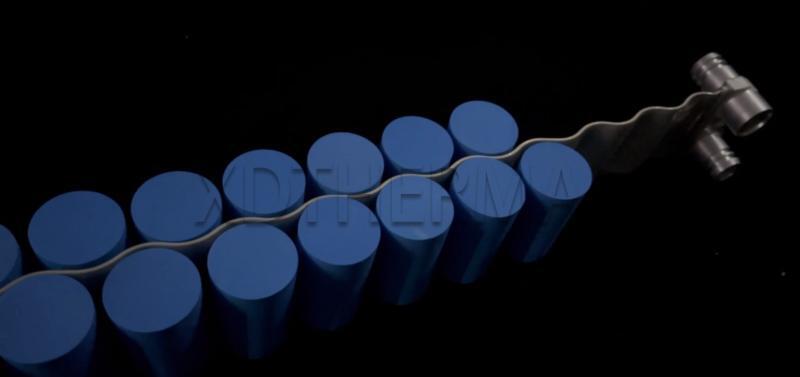In der sich ständig weiterentwickelnden Welt der Lithiumbatterien spielt die Verpackungsform eine entscheidende Rolle bei der Bestimmung der Leistung, Effizienz und Sicherheit dieser Energiespeichergeräte. Ganz gleich, ob Sie ein Elektrofahrzeug fahren, ein Smartphone benutzen oder mit Industrieanlagen arbeiten, die Art der Lithiumbatterie im Inneren hat einen erheblichen Einfluss auf Ihre Erfahrungen. Lassen Sie uns in die faszinierende Welt der Lithiumbatterie-Verpackungen eintauchen und die drei Hauptformen erkunden: quadratisch, zylindrisch und Softpack.
Quadratische Lithiumbatterien, die oft auch als prismatische Batterien bezeichnet werden, sind von einer rechteckigen Hülle umgeben, die in der Regel aus Aluminium oder Stahl besteht. Diese Batterien können je nach den spezifischen Anforderungen der Anwendung entweder im Wickel- oder im Laminierverfahren hergestellt werden.
Bei der Herstellung von quadratischen Batterien werden die Zellen entweder in eine kompakte Form gewickelt oder es werden Schichten von Zellen übereinander gelegt, um die endgültige Struktur zu erhalten. Diese Methode ermöglicht eine größere Flexibilität in Bezug auf Design und Größe der Batterie, so dass sie für verschiedene Anwendungen geeignet ist.
Vorteile:
Quadratische Batterien können eng aneinander gepackt werden, wodurch der Platz optimal genutzt und die Gesamteffizienz des Batteriepacks verbessert wird.
Aufgrund ihres Designs haben quadratische Batterien oft eine größere Einzelzellenkapazität als zylindrische Batterien, was sie ideal für Anwendungen macht, die eine hohe Ausgangsleistung erfordern.
Das unkomplizierte Design quadratischer Batterien vereinfacht den Herstellungsprozess und reduziert mögliche Fehlerquellen.
Benachteiligungen:
Die Erzielung einer gleichmäßigen Leistung über alle Zellen in einem quadratischen Akkupack kann eine Herausforderung sein, die zu Problemen mit der Zuverlässigkeit führen kann.
Das Design quadratischer Batterien kann die effektive Wärmeableitung erschweren, was sich auf Leistung und Sicherheit auswirken kann. Die Optimierung von Batteriepackstrukturen auf der Grundlage thermodynamischer Analysen kann die Wärmeableitung verbessern und eine gleichmäßige Temperaturverteilung gewährleisten. (Li et al., 2022)
Zylindrische Lithiumbatterien gehören zu den gebräuchlichsten Batterietypen und zeichnen sich durch ihre röhrenförmige Form aus. Diese Batterien sind in der Regel in einer zylindrischen Stahlhülle untergebracht, die einen robusten Schutz und eine lange Lebensdauer bietet.
Die Zellen in zylindrischen Batterien werden in einem Wickelverfahren hergestellt, bei dem Schichten von Elektrodenmaterial aufgerollt werden, um in das zylindrische Gehäuse zu passen. Diese Methode ist hocheffizient und kostengünstig, weshalb sie in verschiedenen Branchen beliebt ist.
Vorteile:
Zylindrische Batterien sind für ihre zuverlässige und gleichbleibende Leistung über alle Zellen hinweg bekannt, was für Anwendungen, bei denen Gleichmäßigkeit von entscheidender Bedeutung ist, entscheidend ist.
Das Herstellungsverfahren für zylindrische Batterien ist gut etabliert und hocheffizient, was zu niedrigeren Produktionskosten führt.
Zylindrische Batterien können dank ihres Designs Wärme effektiv ableiten, was zur Aufrechterhaltung der Leistung und Sicherheit bei starker Beanspruchung beiträgt. Die Kombination von PCM aus Paraffinwachs und expandiertem Graphit mit einer Flüssigkeitskühlung verbessert die Temperaturgleichmäßigkeit erheblich und reduziert die maximalen Oberflächentemperaturen in zylindrischen Batteriepacks (Wang et al., 2023). Zusätzlich kann ein zentraler Kühlkörper die Wärmeableitung weiter verbessern. (Aryanfar et al., 2023).
Benachteiligungen:
Trotz ihrer Vorteile haben zylindrische Batterien im Vergleich zu anderen Formen oft eine geringere Energiedichte, was ihre Verwendung in Anwendungen, die eine hohe Leistung bei kompakter Größe erfordern, einschränken kann.
Die Notwendigkeit, viele Zellen zu einem Akkupack zu vereinen, kann die Verwaltung und Wartung erschweren, was zu Problemen mit der Langlebigkeit und Zuverlässigkeit führen kann.
Soft-Pack- oder Pouch-Batterien zeichnen sich durch ihr flexibles Gehäuse aus Aluminium-Kunststoff-Folie aus. Diese einzigartige Verpackung ermöglicht ein leichtes und anpassungsfähiges Batteriedesign.
Softpack-Batterien werden in der Regel in einem Laminierungsverfahren hergestellt, bei dem Schichten von Elektrodenmaterialien übereinandergelegt und in das flexible Gehäuse eingeschlossen werden. Diese Methode ermöglicht eine größere Anpassungsfähigkeit der Batterieform und -größe.
Vorteile:
Soft-Pack-Batterien bieten eine hohe Energiedichte und liefern mehr Leistung in einem kleineren und leichteren Paket.
Diese Batterien weisen in der Regel eine hervorragende elektrochemische Leistung auf, was sich in einer höheren Effizienz und Zuverlässigkeit niederschlägt.
Das flexible Gehäuse von Softpack-Batterien kann Stöße absorbieren und die Gefahr von Kurzschlüssen verringern, was die Sicherheit erhöht.
Die Anpassungsfähigkeit von Softpack-Batterien macht sie ideal für Anwendungen, bei denen Platz und Gewicht kritische Faktoren sind.
Benachteiligungen:
Die Aufrechterhaltung einer hohen Konsistenz über alle Zellen in einem Soft-Pack-Akkupack ist von entscheidender Bedeutung, stellt jedoch eine Herausforderung dar und beeinträchtigt die Zuverlässigkeit.
Die flexible Beschaffenheit von Softpack-Batterien kann es schwierig machen, einen hohen Gruppenwirkungsgrad zu erreichen, da sie nicht so dicht gepackt werden können wie andere Formen.
Die Materialien und Herstellungsverfahren für Softpack-Batterien können teurer sein, was zu höheren Kosten führt.
Beim Vergleich der Effizienz und Leistung verschiedener Verpackungsformen ist es wichtig, die jeweilige Anwendung zu berücksichtigen. Quadratische Batterien bieten einen hohen Gruppenwirkungsgrad und große Einzelkapazitäten, wodurch sie sich für Hochleistungsanwendungen eignen. Zylindrische Batterien bieten eine gleichmäßige Leistung und eine robuste Wärmeableitung, ideal für Situationen, in denen die Zuverlässigkeit entscheidend ist. Softpack-Batterien mit ihrer hohen Energiedichte und ihrem flexiblen Design sind perfekt für leichte und kompakte Anwendungen.
Die Energiedichte ist ein entscheidender Faktor für die Leistungsfähigkeit von Batterien. Softpack-Batterien sind in dieser Kategorie führend und bieten die höchste Energiedichte unter den drei Formen. Quadratische Batterien bieten ebenfalls eine gute Energiedichte, während zylindrische Batterien trotz ihrer anderen Vorteile oft eine geringere Energiedichte aufweisen.
Sicherheit ist bei der Entwicklung von Batterien von größter Bedeutung. Weichpackungsbatterien sind aufgrund ihres flexiblen Gehäuses, das Stöße absorbieren kann, besonders sicher. Zylindrische Batterien bieten ebenfalls starke Sicherheitsmerkmale, da ihre robuste Stahlhülle einen hervorragenden Schutz bietet. Quadratische Batterien sind zwar sicher, haben aber Probleme mit der Wärmeableitung, was die Sicherheit insgesamt beeinträchtigen kann.
Die Kosten sind ein wichtiger Faktor bei der Auswahl von Batterien. Zylindrische Batterien sind aufgrund ihres effizienten Herstellungsverfahrens in der Regel am kostengünstigsten. Quadratische Batterien bieten ein ausgewogenes Verhältnis zwischen Kosten und Leistung, während Softpack-Batterien trotz ihrer höheren Kosten eine höhere Energiedichte und Flexibilität bieten.
Ein wirksames Wärmemanagement ist entscheidend für die Aufrechterhaltung der Batterieleistung und -sicherheit. Eine schlechte Wärmeableitung kann zu Überhitzung führen, was die Lebensdauer der Batterie verkürzt und das Ausfallrisiko erhöht.
Seitenkühlung mit Serpentinen-Flüssigkeitskühlrohren
Eine gängigere Methode ist die Verwendung von Serpentinen-Flüssigkeitskühlrohren für die Seitenkühlung, die ein effizientes Wärmemanagement für den gesamten Batteriesatz ermöglicht.
Kühlung von unten
Einige zylindrische Batterien verwenden Flüssigkeitskühlplatten für die Bodenkühlung, was zu einer effektiven Wärmehaltung beiträgt.

Wärmeableitung an der Unterseite
Sowohl bei quadratischen als auch bei Soft-Pack-Batterien werden häufig Methoden zur Wärmeableitung von unten verwendet, die zur Aufrechterhaltung von Leistung und Sicherheit beitragen.
Aufkommende Techniken zur Wärmeableitung an der Seite
Um das Wärmemanagement in diesen Batterien zu verbessern, werden derzeit innovative Ansätze entwickelt, darunter die seitliche Wärmeableitung und hybride Methoden, die Seiten- und Bodenkühlung kombinieren. Eine Änderung der Höhe, des Winkels und der Anzahl der Luftein- und -auslässe kann die Wärmeableitungsleistung von Lithium-Ionen-Akkupacks erheblich beeinflussen (Dai & Wang, 2023).
Die Lithiumbatterie-Industrie entwickelt sich ständig weiter, und es werden neue Technologien und Materialien entwickelt, um Leistung, Sicherheit und Effizienz zu verbessern. Die Verwendung von Phasenwechselmaterialien in Verbindung mit Flüssigkeitskühlung optimiert die Wärmeableitung in Batteriepacks (Lin et al., 2022).
Hybride Kühlmethoden, die verschiedene Wärmeableitungstechniken kombinieren, werden erforscht, um das Wärmemanagement in Batteriepacks zu verbessern.
Fortschritte in der Materialwissenschaft führen zur Entwicklung neuer Elektroden- und Gehäusematerialien, die die Leistung und Sicherheit von Lithiumbatterien verbessern. Die Verwendung zentraler Kühlkörper und innovativer Konstruktionen wie gestaffelte bidirektionale Strömungskühlung und dreieckige Spoiler tragen ebenfalls zu einer verbesserten thermischen Leistung bei
Die Verpackung von Lithiumbatterien - quadratisch, zylindrisch und weich verpackt - hat Auswirkungen auf Leistung, Effizienz und Sicherheit. Quadratische Batterien bieten einen hohen Wirkungsgrad, haben aber Probleme mit der Wärmeableitung. Zylindrische Batterien bieten eine gute Wärmeableitung und Konsistenz, haben aber eine geringere Energiedichte. Softpack-Batterien sind flexibel und haben eine hohe Energiedichte, sind aber teurer.
Ein wirksames Wärmemanagement ist entscheidend. Zu den Fortschritten gehören Phasenwechselmaterialien mit Flüssigkeitskühlung, optimierte Luftdesigns und hybride Kühlmethoden, die die Leistung und Sicherheit aller Batterietypen verbessern.
Die Haupttypen von Lithiumbatterieverpackungen sind quadratisch (prismatisch), zylindrisch und als Softpack. Jeder Typ hat unterschiedliche Eigenschaften und Anwendungen.
Eine wirksame Wärmeableitung ist entscheidend für die Aufrechterhaltung der Leistung, Sicherheit und Langlebigkeit von Batterien. Schlechtes Wärmemanagement kann zu Überhitzung, verkürzter Lebensdauer und erhöhtem Risiko eines Batterieausfalls führen.
Zylindrische Batterien verwenden in der Regel eine Seitenkühlung mit Serpentinen-Flüssigkeitskühlrohren und eine Bodenkühlung mit Flüssigkeitskühlplatten. Viereckige und Soft-Pack-Batterien nutzen häufig die Wärmeableitung von unten, wobei neue Techniken die Seiten- und Bodenkühlung kombinieren, um das Wärmemanagement zu verbessern.
Zu den neuen Technologien gehören hybride Kühlmethoden, bei denen Phasenwechselmaterialien und Flüssigkeitskühlung kombiniert werden, optimierte Luftstromdesigns und Fortschritte in der Materialwissenschaft zur Verbesserung der Leistung, Sicherheit und Effizienz von Lithiumbatterien.

Ich arbeite seit über 5 Jahren im Bereich des Wärmemanagements von Batterien und habe viele internationale Projekte betreut. Wenn Sie sich für Produkte oder Dienstleistungen zur Flüssigkeitskühlung von Batterien interessieren, können Sie mir gerne Fragen stellen!